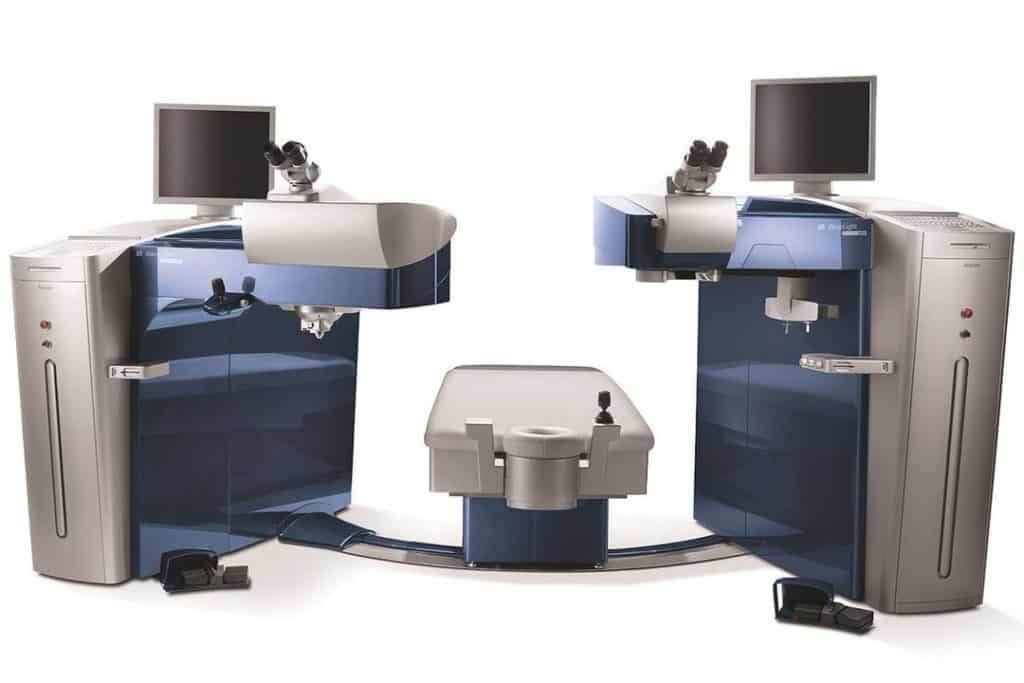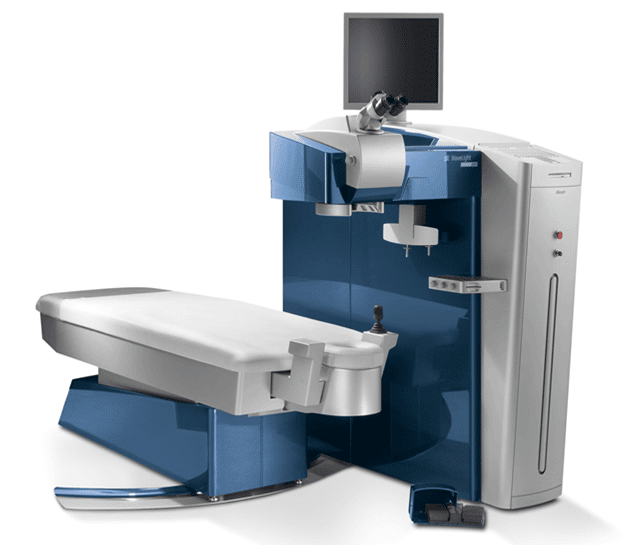Our LASIK Refractive Suite includes the Wavelight Allegretto EX500 HZ Excimer laser, FS200 femto laser and a topography guided software system and laser.
These lasers are finely calibrated and never leave our clinics, unlike in some other centers where they share mobile laser equipment.
Clemson Eye’s lasers are integrated, communicating with each other on the fly to produce highly specific calculations. The computer-generated calculations reduce any possible transcription errors and make for faster, highly accurate procedures and excellent visual outcomes.
The average treatment time under the laser is 10 seconds. Through this advanced technology, we are able to treat many patients who were not considered LASIK candidates in the past.
Schedule consultation or take our LASIK self-test to find out.
At Clemson Eye, we are dedicated to delivering superior care. Not all LASIK procedures are created equal. Some outcomes are better than others, depending on many factors, including the equipment and technique used. The problem is, many LASIK systems work purely off your eyeglass or lens prescription and don’t account for the things that make your eyes special. We use OptiLASIK® Laser Vision Correction to guide our overall measurement and surgical planning. It combines today’s most advanced surgical technologies into a procedure that works with your eyes’ special traits for a more natural shape.

In 2016, Clemson Eye purchased a topography guided laser system. This technology represents a new frontier in vision correction. The system uses topographic measurements of a patient’s corneal shape. This is different than traditional Wavefront laser technologies, which address aberrations in the eye’s optical path only. The topography guided treatment incorporates the patient’s refractive error and corneal irregularities into a highly customized map of their eye. This map provides a more personalized treatment plan, precisely customized to the individual’s corneal shape and contour. With the new topographers, we can measure approximately 22,000 points of curvature on the cornea versus 168 points through traditional topographers, allowing for greater customization and accuracy in treating the refractive error. These advancements improve surgical planning and visual outcomes for all LASIK patients. But they are particularly beneficial to patients with irregular corneas caused by past surgery, eye disease or corneal scarring due to contact lens wear. With this new technology, Clemson Eye can now treat patients who were not considered candidates for LASIK in the past. Topography guided systems were approved for use in the United States in 2014. Results from a recent study1 exceeded expectations. When treated with a topography guided system, 92.7% of all patients achieved an uncorrected visual acuity (UCVA), that is vision without glasses, of 20/20 or better, and 68.8% achieved a UCVA of 20/16 three months after surgery.2 In addition, 29.6% gained at least one line of best spectacle-corrected visual acuity (BSCVA) three months after surgery. This means their vision after topography guided LASIK was even better than their best vision with glasses before their surgery. Symptoms traditionally associated with LASIK, such as glare, halos, difficulty driving at night, light sensitivity and eye dryness, also improved after topography guided LASIK treatment. 1. Results from FDA T-CAT-001 clinical study for topography-guided vision correction (with the 400 Hz ALLEGRETTO WAVE® Eye-Q Excimer Laser). 2. Post hoc analysis of postoperative UCVA compared to preoperative BSCVA of 230 eyes contained in the FDA T-CAT pivotal trial at 12 months. The primary end point evaluated changes in BSCVA.

This revolutionary system surpassed all previous LASIK systems with faster procedures, superior results, and fewer side effects. The EX500 Excimer is our laser of choice for the following reasons:
The first generation of LASIK procedures involved a handheld bladed incision to create the thin flap. The blade is called a microkeratome. The second step consisted of reshaping the cornea with an excimer laser. The majority of the problems associated with LASIK are largely related to the use of a handheld, bladed microkeratome, which some LASIK surgeons still use. At Clemson Eye, a blade-free femtosecond laser is used to gently create a picture perfect corneal flap. By eliminating the microkeratome, we remove all blade-related complications. Clemson Eye was the first LASIK provider in the Upstate to perform LASIK with a femtosecond laser. Even though using a mechanical microkeratome is a very cost effective approach for surgeons, Dr. Parisi does not even keep one in the surgery suite. He says, “It’s like comparing an iPod to an 8 track player. Why would you keep it around when technology has evolved so much?”.There are a substantial number of FDA trials that also prove the benefits of the all-laser LASIK procedure used at Clemson Eye. The Wavelight FS200 Femtosecond Laser makes the flap within six seconds and it works with a precision of one trillionth of a second. This procedure is fully computer controlled. The main benefits of bladeless LASIK include:
In 2013, the FDA granted Alcon approval on Contoura Vision (Topography Guided Ablation) and it has given the US surgeons a new and improved paradigm for enhancing the outcomes of Lasik on virgin eyes that have never been attained before. At 12 months the following visual acuity results were attained:
The FDA also gave Alcon these 7 claims that have never been given before for a Lasik trial. These symptoms usually increase with other Lasik treatments Post-op symptoms at 12 months:
1. Results from FDA T-CAT-001 clinical study for topography-guided vision correction (with the 400 Hz ALLEGRETTO WAVE® Eye-Q Excimer Laser).